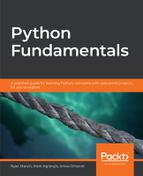Book Description
With an interesting mix of theory and practicals, explore Python and its features, and progress from beginner to being skilled in this popular scripting language
Key Features
- A comprehensive introduction to the world of Python programming
- Paves an easy-to-follow path for you to navigate through concepts
- Filled with over 90 practical exercises and activities to reinforce your learning
Book Description
After a brief history of Python and key differences between Python 2 and Python 3, you'll understand how Python has been used in applications such as YouTube and Google App Engine. As you work with the language, you'll learn about control statements, delve into controlling program flow and gradually work on more structured programs via functions.
As you settle into the Python ecosystem, you'll learn about data structures and study ways to correctly store and represent information. By working through specific examples, you'll learn how Python implements object-oriented programming (OOP) concepts of abstraction, encapsulation of data, inheritance, and polymorphism. You'll be given an overview of how imports, modules, and packages work in Python, how you can handle errors to prevent apps from crashing, as well as file manipulation.
By the end of this book, you'll have built up an impressive portfolio of projects and armed yourself with the skills you need to tackle Python projects in the real world.
What you will learn
- Use control statements
- Manipulate primitive and non-primitive data structures
- Use loops to iterate over objects or data for accurate results
- Write encapsulated and succinct Python functions
- Build Python classes using object-oriented programming
- Manipulate files on the file system (open, read, write, and delete)
Who this book is for
Python Fundamentals is great for anyone who wants to start using Python to build anything from simple command-line programs to web applications. Prior knowledge of Python isn't required.
